I was passing through Liverpool lately and thought I would take a sentimental journey (after the title of one of his solo albums) into the city’s South End to look at the two houses Ringo Starr lived in before the Beatles made it big. Beyond knowing that neither had been converted into a museum I had done no research, but when I got there I found the actual state of the properties far more affecting than I had expected.
The area in question is perhaps a mile-and-a-half’s amble southward from the city centre, in the region of Princes Park. It is an area of great contrasts, where mass-produced nineteenth-century terraced housing is just minutes’ walk from the grand Victorian and Edwardian mansions surrounding Princes Park and lining its approach roads. I have read that the terraced streets hereabouts were notoriously rough and deprived in Ringo’s 1940s and 50s childhood and that, of the four Beatles, his was the humblest upbringing. 10 Admiral Grove, where Ringo lived for many years with his mother and step-father after his parents separated, is reached along a short, narrow, paved passage, running behind the Empress pub (off High Park Street).
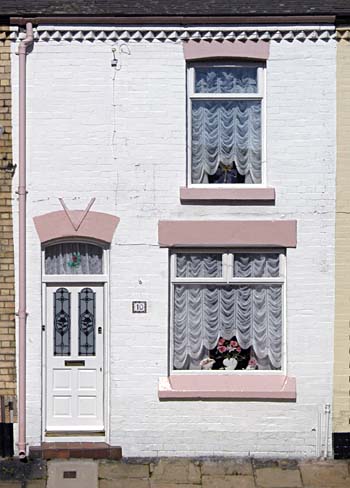
“10 Admiral Grove” by Stundra
As you can see, the house is painted in a decidedly un-rock-and-roll wedding-cake colour scheme and is a very modest one. It is of the type where the front door opens directly into the lounge and where there would have been only two rooms on each floor, upstairs and down. I gather that the houses Ringo now revolves between are somewhat larger and are sited in sunnier and more exotic international locations.
There is some black and white footage (apparently staged, unfortunately) of Ringo being mobbed by teenagers here in 1963, as he exits the house and tries to join George Harrison who is awaiting him in an open-topped sports car. Standing outside, I talked to some (admirably tolerant) neighbours who said that the house had belonged until recently to a now deceased old lady. I peeked through the window to see that the interior has been stripped of all its furnishings including carpets, indeed the very walls have been scraped back to the bare plaster and the fire-place has been filled (presumably to deter souvenir hunters).
The house where Ringo was born, and lived for his first few years, is over the other side of High Park Street and a little way down Madryn Street, which leads off it.
Number 9 is still standing, but the whole street is empty of residents and all the windows and doors are steel-shuttered.
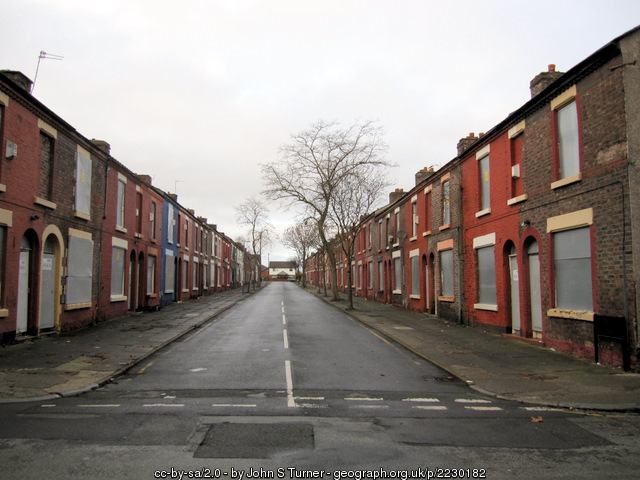
Madryn Street, Toxteth, looking North-west
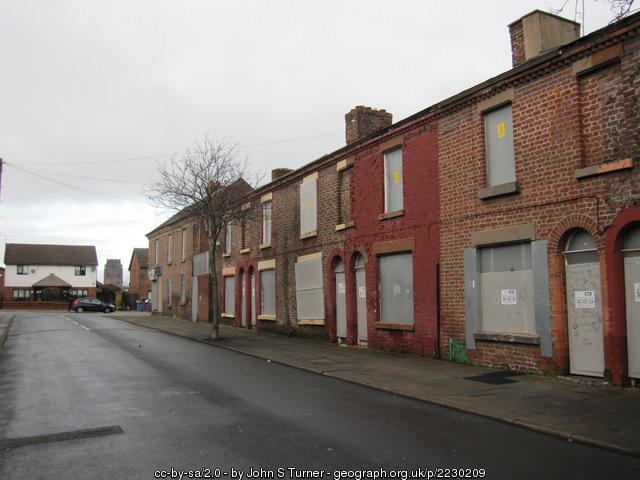
North-west end of Madryn Street
Ringo’s former house is the first on the right, with its shutters covered in graffiti. It has been re-pointed relatively recently, perhaps as a prelude to a projected restoration.
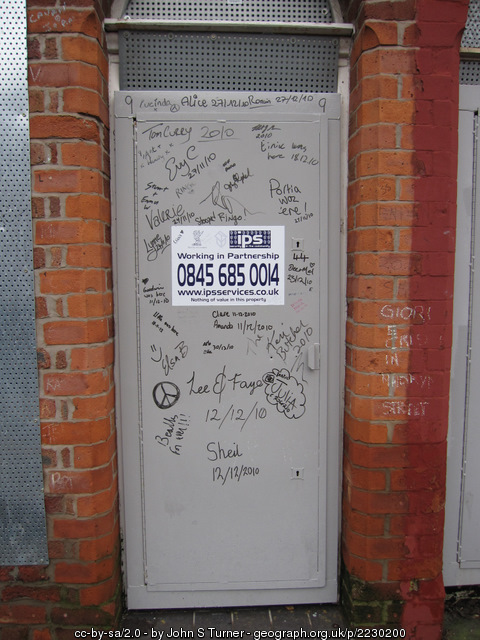
The security door and graffiti at 9 Madryn Street, Toxteth
One learns from the dates on some of the graffiti that the shutters are at least five years old. Apparently there is an ongoing tussle over whether this piece of Beatles memorabilia merits being saved from demolition, but the whole street has also been standing empty alongside it for that time. In fact, as I soon learnt from exploring further, it is part of a much larger section of housing on this side of the main road that is in exactly the same condition. Six parallel streets (Wynnstay St, Voelas St, Rhiwlas St, Powis St, Madryn St itself, and Kinmel St) known collectively from their names as “the Welsh Streets”, are empty and closed-up in the same fashion.
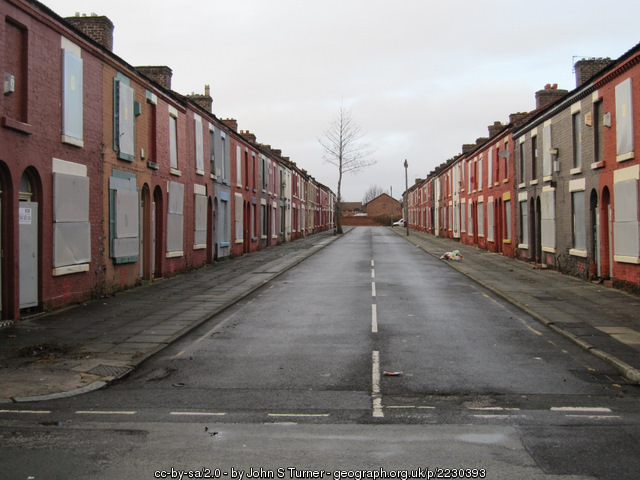
Powis Street, Toxteth

Wynnstay Street, Toxteth. The tower of the Anglican Cathedral can be seen in the distance. There is evidence of bomb damage to the right-hand terrace, where a gap has been filled with post-war housing.
It is easy to imagine these streets being thronged with people, and strange to think that so large an area would be left in this sort of limbo for so long. Though obviously dilapidated the buildings do not seem positively derelict, and most of their roofs and basic structures seem intact. There is none of the blackened fire-damage and randomly strewn rubbish that normally marks an area’s slide into terminal dereliction. Nor is there the sense of unease and threat to the idle visitor usually present in such places, since no other human beings are to be seen. The thoroughfares and pavements are remarkably neat, with trees still pleasantly punctuating several of them, and one small area cleared of its houses many years ago seems to have served the locals as a little park:
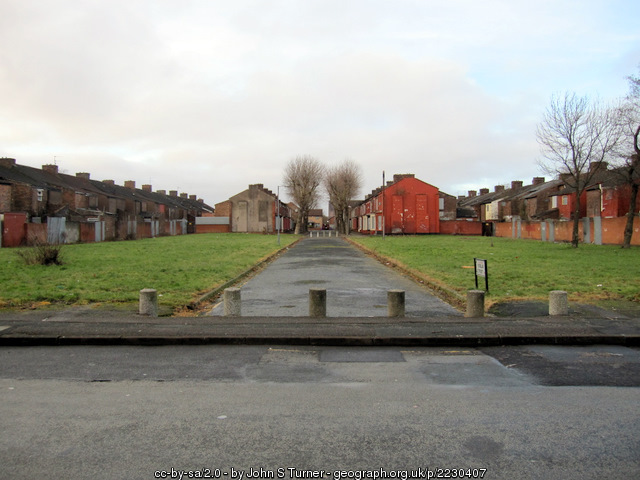
Voelas Street, Toxteth
The overall effect is quite eerie in its complete depopulation, like a sort of Marie Celeste of South Liverpool. A passer-by unaware of its famous former resident might wonder why taxis periodically park outside one undistinguished boarded-up house on Madryn Street, and disgorge visitors who gaze at it gape-mouthed and who are lectured knowledgably about its part in popular culture by their driver, who apparently knew all the main players in the Beatles’ rise to fame personally.
Obviously, there is a contest going on between those who want refurbishment and those who want to knock it all down and start again. At one point out on High Park Street an official sign, which has apparently been there for some time, trumpets the region as “Princess Park Regeneration Zone” and talks of “Creating neighbourhoods of the future.” There is a picture of happy future residents swanning about. But the pubs and shops, that would have faced along the main road and provided the community with its focus, are long since demolished. It seems that the “zone” has been embalmed indefinitely against some future moment when conditions will somehow be propitious for it to be occupied again.
The ghostly desolation made me think about the thousands upon thousands of people who lived (and maybe died) here and pursued their day-to-day lives down the generations, from the 1880s when these streets were first constructed. Maybe the relevant authorities are waiting for Ringo to return to Liverpool and summon the people back, like a pied-piper (or pied-drummer) in reverse, so that the homes can be reopened and refitted and returned to productive life.
